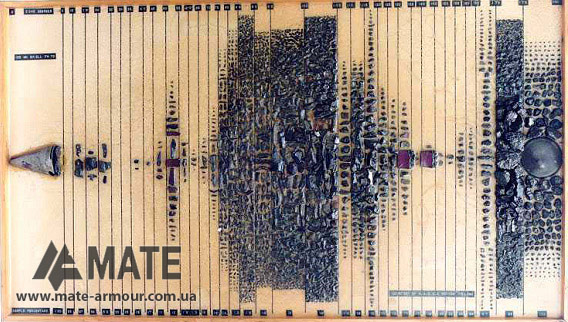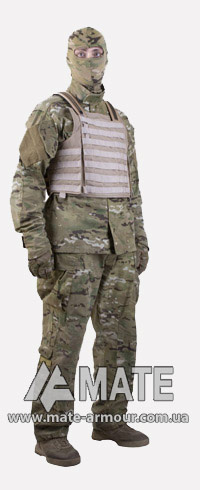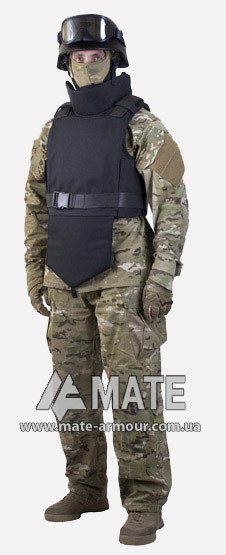Materials used for body armours producing
Hidden wearing
- Comfort, invisibility
- Small weight
- Small thickness
- As a rule up to the 2-nd protection class
External wearing
- More protection class due to using of armour plates
- As a rule from the 2-nd to the 6-th protection class
| 1 class | 2 class | 3 class | 4 class | 5 class | 6 class | |
|---|---|---|---|---|---|---|
| Fabrics of aramid or PE (polyethylen) fibres | • | • | ||||
| Soft armour, UD-polyethylen or aramid | • | • | ||||
| Plastic armour plate | • | • | • | |||
| Steel armour plate | • | • | • | • | ||
| Composite ceramic plate | • | • | • | • | • | • |
Ballistic-proof and splinterproof armour helmets
1. Origin
About a century B.C. – leather helmet of Roman legionaries
About 12 century A.D. – steel knight helmet
About 1910 – steel helmet against ballistic defeat
1980 – helmet PSGT (Personal Armor System Ground Troops)
About 12 century A.D. – steel knight helmet
About 1910 – steel helmet against ballistic defeat
1980 – helmet PSGT (Personal Armor System Ground Troops)
2. Soldier's armour protection was required
Splinters defeat peculiarities
Splinters defeat peculiarities
|
Splinter speed (m/sec)
|
% defeat
|
|
50 – 380
|
50%
|
|
50 – 450
|
75%
|
|
50 – 530
|
90%
|
|
50 – 760
|
95%
|
|
50 – endlessness
|
100%
|
3. Soldier's helmet was required
75-80% defeat - SPLINTERS
20% - BULLETS
45% of all splinters defeat occur to the head
The missile burst (data as per 135-mm missile L5A1) forms:
0.1 g – 1.0 g 77%
1.0 g – 10.0 g 21%
10.0 g – 140.0 g 2%
(Artillery shell 155 mm)

4. Protection features
-
Ballistic protection
- Ballistic resistance
- Splinterproof firmness
-
Behind armour contusion trauma
-
Shockproof protection
- Guided mass impacts buffering
5. Design and physical mechanical properties
- Weight
- Fire-resistance
- Quality wearing
- Maintainability
-
Others...
6. Service/Operation performances
- Compatibility with clothes
- Compatibility with weapon
- Service life
- Conventional sitting (adjustment)
-
Others...
7. Materials for armour helmets producing
-
Steel, titanium, aluminium alloys (5%)
-
Aramid materials (80%): Twaron ® (Teijin Aramid, the Netherlands)
- Kevlar ® (Dupon, the USA)
- Kherakron® (Colon, Korea)
-
SVM, RUSAR® (Russia)
-
Materials of high modulus polyethylen (15%)
- Dyneema® (DSM, the Netherlands)
-
Spectra® (the USA)
-
Zylon® (PBO)
- "Ballistic" nylon
8. Materials for armour helmets producing
-
Aramid armour helmets:
- pressurized
-
with DFM
- Metallic composite armour helmets
- High modulus polyethylen armour helmets
9. Materials for armour helmets producing
|
|
Secondary splinters
|
Weight/
Protection features (1-10) |
Radar determi-nation
|
Fire-resistance
|
Design rigidity
|
Trauma (1-5)
|
Climatype
|
|---|---|---|---|---|---|---|---|
|
Aramid a/h (1 class)
|
-
|
7
|
-
|
+
|
+
|
4
|
+
|
|
Aramid a/h (1A class)
|
-
|
8
|
-
|
+
|
-
|
2
|
+
|
|
Metallic composite a/h
(2 class)
|
-
|
6
|
+
|
+
|
+
|
5
|
-
|
|
A/h of high modulus PE (1 class)
|
-
|
9
|
-
|
-
|
-/+
|
2
|
-/+
|
|
A/h of high modulus PE (1A class)
|
-
|
10
|
-
|
-
|
-/+
|
1
|
-/+
|
Armour helmet of aramid materials (regular treatment)
armour helmet weight 1.5 - 1.6 kg (protection class 1A DSTU V 4103-2002)
V50=600 - 650 m/sec
Performance "discrete fabric materials" (untreated central part)
armour helmet weight 1.4 kg (protection class 1 DSTU V 4103-2002)
armour helmet weight 1.9 kg (protection class 2 DSTU V 4103-2002)
Aramid armour helmets:
-
Pressurized
- Optimum balance
- weight/protection features
- Secondary splinters absence
- Radar not determined
-
Good heat proof
-
With DFM
- Low design stability
-
High exponent of trauma
High modulus polyethylen armour helmet:
armour weight 1.2 kg (protection class 1 DSTU V 4103-2002)
V50=600 m/sec
armour weight 1.6 kg (protection class 1A DSTU V 4103-2002)
V50=680 m/sec
armour weight 1.2 kg (protection class 1 DSTU V 4103-2002)
V50=600 m/sec
armour weight 1.6 kg (protection class 1A DSTU V 4103-2002)
V50=680 m/sec
Advantages:
- Unique balance exponent
- Weight/protection features as per class 1, 1A DSTU V 4103-2002
- Secondary splinters absence
- Radar not determined
Disadvantages:
- Low heat proof
- Steam deactivation impossibility (170оС)
- High price
- High trauma exponent
10. Summary
It is necessary to determine the following items for armour protection selection:
It is necessary to determine the following items for armour protection selection:
- Required protection level as per ballistic-proof / splinterproof firmness
- Shell material / armour packet material (operating conditions)
- Harness system type (for helmet)
- Shape (ergonomics)
- Scope (foot troops, special forces, armoured vehicle operator, mine picker, sniper, flamethrower operator, etc.)


